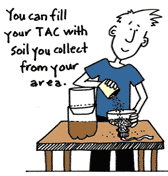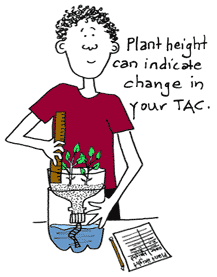|
 A
simple model, a complex world: The TerrAqua Column, a relatively
simple model, allows you to focus on specific aspects of a complex
world. Imagine, for example, a lake near your house that is suddenly
overtaken with algae. A
simple model, a complex world: The TerrAqua Column, a relatively
simple model, allows you to focus on specific aspects of a complex
world. Imagine, for example, a lake near your house that is suddenly
overtaken with algae.
Given all the environmental factors that influence the lake, you
would be hard pressed to determine exactly which factors encouraged
the slimy green stuff to get out of control.
You could build several TerrAqua Columns in order to explore specific
factors that might encourage algae. Try taking samples of lake water
and local soil, for example, and then testing them under different
conditions to see in what sorts of environments algae grows best.
Your observations and experiments can go in many directions, so
the clearer you are in defining your question and designing your
experiment, the more successful your experiment will be.
 Variables:
Variables to consider in your experiments include: Variables:
Variables to consider in your experiments include:
- The type and amounts of soil, water, and plants – remember,
depending on their source, the soil and water will likely contain
such life as algae, fungus, mites, Daphnia, etc.
- Substances that might affect terrestrial and aquatic systems
– nutrients (fertilizers), or pollutants (salts, pesticides, acids).
- A treatment plan – once you have decided on a substance to
test you can apply different amounts of that substance; treat
only the terrestrial chamber; treat only the water reservoir;
apply it directly to plant leaves; test it on plants of various
ages; or vary the treatment schedule.
- Physical factors – temperature, light, sound, etc. (Try singing
or screaming at your plants. One student grew Fast Plants to the
tunes of Bach, Barry Manilow and Heavy Metal - Barry Manilow encouraged
the most growth!!)
Indicators: Indicators in a TAC are plants
and animals and other system characteristics that change in response
to your experiments, giving you information regarding your hypothesis.
Indicators include terrestrial and aquatic plants and the pH
of soil and water.
Some observations you can make of a plant indicator, for example,
include percentage of seeds that germinate, plant height and weight,
leaf size and shape, root structure, number of flowers, length of
life cycle and seed production. In the aquatic system, indicators
include increases or decreases in populations of algae and duckweed.
These changes can show up as cloudiness in the water. You can also
use the bioassay to determine the effects
of a substance on plants.
 Controls:
With every experiment you run, set up one control TAC in which you
do not vary any of the components. This acts as a standard against
which you can compare the effects of variables you do change. Controls:
With every experiment you run, set up one control TAC in which you
do not vary any of the components. This acts as a standard against
which you can compare the effects of variables you do change.
Keep it simple: The TAC is a simple
model, but all of its parts are dynamic. Keep your investigations
very simple by changing only one variable of the system at a time.
Some of the more often investigated substances include fertilizer,
pesticides, acid "rain" and oil. A detailed example of a salt pollution
experiment follows; you can also use the procedure to investigate
other substances.
|

